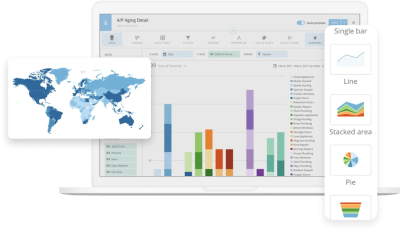Top 10 dashboard design mistakes (and what to do about them)
Dashboards can be game-changing for businesses, allowing them to turn large, hard-to-analyze datasets into a single screen that delivers the overall picture of company performance.
Effective dashboard design ensures that everyone can understand data, and poor dashboard design does the opposite.
However, executing a flawless dashboard design is easier said than done. New dashboard builders often make a number of mistakes during the dashboard design process.
With this in mind, here are the top ten dashboard design mistakes to avoid in order to create the most effective dashboard.

1. Designing the dashboard with no clear goal in mind
A quality dashboard displays the metrics most critical to accomplishing a particular goal or business objective, giving dashboard users all the information they need to take action to further their progress towards that goal.
So, if dashboard design is completed without keeping the aim of the dashboard in mind, the dashboard isn’t going to be as effective– compared to if you’d created a mission statement for the dashboard first.
To avoid this problem, figure out the goal of your dashboard before you start building it. This will help to focus the dashboard design process, leading to an end result that’s clearer, easier to read, and more effective at conveying insight.
2. Not taking the dashboard user into consideration
While it’s a huge mistake to begin dashboard design without a clear vision in mind for the objective of the dashboard, sometimes the dashboard design process can focus too much on the goal and fail to consider its audience.
If the dashboard designer doesn’t take the end user into account, they can end up with a dashboard that doesn’t meet their needs. Depending on who the end user is, there will be differences in the volume of detail required, the data sources used, and the visualizations chosen, among other things.
For some, such as C-suite executives, the focus will be on detail– whether this is by providing granularity on the dashboard itself, or by making further detail available with just one click– and providing the KPIs most relevant to key company goals.
From here, they can make the highest-level decisions that drive company performance– based on information from the macro-to the micro-level.
On the other hand, details are going to be less important– and may even obscure the story told by the data– for investors, so the dashboard design should focus on simplicity and the clarity of the message conveyed by the data.
3. Adding unnecessary decoration to the dashboard
Though it can be tempting to add decoration to your dashboard design– with the aim of making it more visually appealing, you should avoid this as much as possible.
A good dashboard is as simply designed as possible. It’s focused, directing the eye to key metrics and data visualizations. Decorations usually just make dashboards less effective.
This is because any distractions from the key metrics detract from a key goal of dashboard design: that it should take no more than 5 seconds to take in the whole of the dashboard and surmise the story told by the data.
Instead, when adding a component to your dashboard design, you should ask: does this add to the purpose of the dashboard, and help the end user achieve their goals? If the answer is no, then it’s probably best to leave it out.

4. Not using enough white space
In contrast to the previous point, a design element that you should make use of in your dashboard design process is white space.
While you might be tempted to use all the space on the dashboard– the end user– this will actually have a negative effect on the attention and engagement of the dashboard viewer.
Using white space strategically between visualizations– or between groups of metrics– helps dashboard users take in each visualization without becoming overwhelmed by the dashboard design. This enables them to better understand the complete story told by the data.
White space also helps to prevent crowding, since adding more white space will limit the amount of visualizations you can put on the dashboard. This way, you have to prioritize which metrics should be included– and which should be left out. A good dashboard is focused– and only has the most important information that users need.
White space even helps the user to remember each metric more effectively, as using white space helps to make each visualization stand out and become more memorable.
5. Failing to group related metrics
Another mistake made while executing dashboard design is including related metrics and visualizations without indicating that they’re linked and, therefore, should be viewed together to understand the complete story of the data.
Dashboards should be organized in a coherent way that makes sense for users looking for information. Regardless of the organizational strategy you use, whether it’s time, topic, or importance, related metrics should have some sort of clear visual connection.
While white space can be used to improve engagement with the dashboard, it can also be used to group related visualizations together.
By reducing the white space between related metrics– and using a comparatively larger volume of white space between the remaining visualizations, dashboard design can be used to emphasize the relationship between certain metrics.
This ensures that your dashboard tells a clear and coherent data story, with a specific order and organization for key metrics.
6. Trying to fit too much into the dashboard
The optimum number of visualizations for a dashboard is around five to nine. Any more than this, and the dashboard user is unlikely to engage with every visualization.
Not only that, too many metrics can distract and confuse the end user. With too many metrics, it’s hard to imply any sort of visual hierarchy or tell a coherent data story. Without a focused dashboard, users can’t get any real insight.
So, try to narrow your visualizations and KPIs to the most important ones for achieving your goals. If you have many more metrics than the optimum number for dashboard design, then it might be worth creating more than one dashboard with a more specific focus.
Using features like embedded links and drill paths, dashboard builders can easily connect their dashboards to each other. This way, if a user wants to see more metrics, they can easily navigate to a dashboard that has those metrics.
7. Not using the optimal visualization for data
Something that’s often underestimated when executing dashboard design is the type of visualization chosen to represent a data set.
A common mistake made when carrying out dashboard design is rushing through the visualization selection process and not choosing the most effective visualization for each data set.
Using appropriate visualizations for your data is crucial for best highlighting the message that the data conveys. For example, bar charts are great for comparisons between multiple variables, while line graphs are optimal for showing how data has changed over time.
Don’t be afraid to use simpler visualizations like basic line charts, gauges, and summary numbers. While many BI tools offer hundreds of different visualizations, the simplest ones are often the most effective.
That being said, you should always take your time to decide which visualizations will convey the meaning of the data best.

8. Using a distracting color scheme
To draw attention to certain metrics or visualizations, it can be tempting to adorn your visualizations with bright, bold colors, but oftentimes this is more overwhelming than engaging.
What’s more, sometimes dashboard design will incorporate colors such as red and green– without taking into consideration the connotations that these colors have (a.k.a. red being negative, green being positive) and assigning them to neutral categories.
This can make the dashboard user perceive neutral dashboard components as good or bad. In addition, using colors that don’t have good contrast or aren’t different enough can make the dashboard harder to read in a more general sense.
So, make sure to use a subtle color palette to enhance dashboard engagement, and avoid using colors with strong associations– unless you actively want those strong associations.
9. Placing dashboard visualizations randomly
One of the most powerful uses of dashboards is being able to tell stories with your data, using dashboard storytelling to illustrate a complete picture of performance and indicate where action is needed.
A key component in achieving this is through the thoughtful positioning and ordering of your data visualizations.
If you place visualizations thoughtlessly on your dashboard, it can confuse your message and make findings from data harder to remember– since they aren’t placed near related insights– and your dashboard may fail to convey the message told collectively by your visualizations.
So, when executing your dashboard design, you should place them in an order that most transparently portrays the picture of performance given by your data.
10. Assuming knowledge on the part of the user
When executing dashboard design, it’s easy to forget to provide context for things that seem obvious to you.
This includes ensuring graphs are clearly labeled, showing context for data on the dashboard– or just a click away– and providing historical data, in cases where past performance is critical to determining whether a current metric is good or poor.
If you fail to provide context, you leave room for misinterpretation of the data, and this can lead to misinformed decisions being made within the business.
So, avoid assuming knowledge on the part of the user and leave no room for misinterpretation. Include context that spells out the meaning of each visualization for the dashboard viewer.
Build better dashboards with BI
Used effectively, dashboards are an extremely powerful tool. They make up the core of many businesses’ data strategies. An effective dashboard helps users to make data-driven decisions, understand their business data in new ways, and track crucial metrics.
To make good use of the powerful dashboarding tools that BI platforms offer, users need to know how to build dashboards in the most effective way possible. By avoiding some of the most common mistakes, dashboard builders can construct dashboards that are simple, coherent, and effective.
Check out some related resources:

Guide to ETL Data Modeling: Process, Techniques, and Best Practices

8 Best AI Tools for Data Visualization






